There’s no doubt that your new Goldendoodle puppy has been well cared for during his/her stay at Goldendoodle Dandies home.
From the day your puppy was whelped he/she has been lovingly protected and socialized. If it has been a while since you have had a new puppy or if this is your first experience with a puppy, we offer and recommend these training guidelines.
Training a Goldendoodle
We recommend that you begin training your puppy early and suggest puppy-training classes. The puppy should be fully immunized before starting formal classes and interacting with other dogs; around 16 weeks of age. The first level of Puppy training teaches loose leashing, come, sit, etc.
All of these are good basics you and your pet need to know. We believe that positive reinforcement is the way to train your puppy. Training is important, so you will enjoy your puppy, as he/she becomes an adult. Everyone loves a well-behaved dog. One of the main reasons that Goldendoodles end up in rescue shelters or the pound is because their owners have failed to provide basic training and they become unmanageable. Train your dog, so they will be enjoyed for all the years of their life.
You will be happier and so will they. Goldendoodles love to please and will work hard for you. A great training book is by my friend Beth Duman, CPDT-KA “The Evolution of Charlie Darwin Partner with your Dog Using Positive Training.”
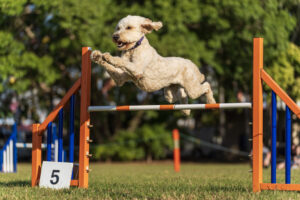
Come Command
Begin to teach your puppy to “come.” At first place puppy a short distance from you and then excitedly call his new name. You can also play this training game between two people calling the puppy back and forth with the “come” command. When he/she gets the idea and begins to “come,” don’t forget to reward the puppy with verbal praise and a little treat…eventually weaning off the treat. His/her attention span is short at this time, so play new games for a few rounds and then wait to play again in a few hours or so. The Come command is important – you want the puppy to come when you are outside and ready to go in and the puppy wants to stay outside and play!
Hand Biting / Nipping
Puppies “play” bite. This is how they interact with their littermates in determining pack rank. Do NOT allow puppies to bite or nip at you. Do NOT play with the puppy where they chase your hands or feet it encourages play biting. Do NOT swat or grab their muzzle playing either. Give a firm “NO” and then distract with a proper toy to play with.
Jumping and Sit Command For Your Puppy
Do NOT allow your puppy to jump on you. If you allow a behavior at 8 weeks, when the puppy is small, the puppy will be confused and not understand why it is not being allowed when they are bigger, heavier, and stronger. Teach your puppy to sit. Once they know the sit command, do not pet your puppy until the puppy sits. If the puppy starts to jump, firmly say NO. Then give the command to sit. Once the puppy is sitting, give praise and then pet.
Socializing
Begin touching and playing with your puppy’s, ears, feet, tail, tummy, looking into his/her mouth etc. We have already begun this process with your puppy. This will prepare your puppy for those times when they must interact with a stranger such as a groomer or the vet. Your puppy should learn to enjoy this experience and accept it as a wonderful and special time to share with you. This activity will pay off in saving you struggles and embarrassment when you visit people who must handle your dog and help to prepare your dog to take the visits in stride.
It is also important to “socialize” your dog during feeding time and playing with toys. Anyone in your family should be able to take food or toys away from your Golden. When feeding your puppy, put your hand in the food bowl. Give your puppy a toy and then take it away. These processes help your puppy to not be dominant or territorial with their food and toys. Retrievers love their toys. A good trick to get them to drop or let go of their toy is to offer a treat. They have to let go of the toy in order to get the treat and are rewarded at the same time.
Give the command, “drop it,” and as soon as they let go, give them praise and a treat. Pulling or prying the toy out of your puppy’s mouth teaches them to “hold” onto it tightly and not let go – it becomes a game to them.
Pet Stores/Dog Parks
Do NOT take your puppy to these areas until they are fully immunized. It is important that your puppy not be exposed to other dog environments until they are fully protected. Walks in the neighborhood are okay – just not “concentrated” dog areas.
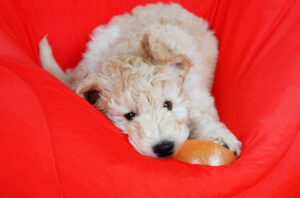
Toys
Your puppy has already begun to play with toys. We suggest toys designed for puppies such as balls, squeaky toys, etc. Make sure the balls are a size that will not go down his throat. Be sure to purchase toys that are safe, so that your pup does not swallow a part that might injure him/her. Your Goldendoodle puppy will enjoy toys during his/her puppy hood, as well as all of his/her life. Goldendoodles love toys, playtime, and time spent with you.
At the pet store you will find an item called a “kong.” This item comes in a “puppy size.” It is a treat as well as a toy. What you do with it is fill the interior with treats and then seal the end with something like peanut butter or cream cheese. The puppy will be occupied for a long time chewing and licking the “kong” in order to get to the treats inside the “kong.” The special toy will keep your puppy happy and occupied again instead of bored and “getting into mischief.”
Goldendoodles LOVE playing with balls — Do not over play with them to avoid an obsession. Tennis balls outer fuzz can become a problem for some dogs teeth – the glue also can wear out the enamel. Reduce tennis ball time or select balls without the fuzz.
Teething
Your puppy will be teething. Please provide him/her with chew toys we recommend the Orka Brand. We also recommend all-natural Buffalo chew sticks. They are safe and healthy alternative to rawhide treats. Rawhides are cured with harsh chemicals (like ash-lye solutions and bleach) and are known to cause choking, throat irritations and intestinal blockages. Buffalo chew sticks are made from free-range, grass-fed buffalo and supply a leaner alternative to beef and provide a rewarding chewing experience your dog will love!
Your puppy will love these. You can order them at www.healthypetslongerlife.com under Dog Treats, then Chew Treats. They also love the Porky Puffs. If you provide “acceptable” things for your puppy to chew on, and if they are readily available to the puppy, then you can guide the puppy in a positive way away from chewing on “unacceptable” things. We recommend that you save the word “no” for extreme and emergency uses only and that you otherwise use “uh-uh” for mild unacceptable behavior correction.
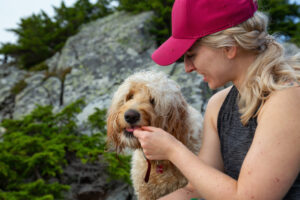
Crate Training and Pens
We recommend crate training with the use of an ex-pen to house train your new puppy. We put the crate inside the ex-pen for those periods of time that the puppy will be left longer than a few hours, so that he does not have an accident in his crate, yet it confines him to a section of the house which is safe. We also use the ex-pen during those periods of time that you can’t fully watch your puppy, but he has just been outside and done his/her “business.” We put the crate inside the ex- pen with the door open (we close it at night for bedtime.) You can see how we have it set up on our blog at: https://GoldendoodleDandies.com/2009/02/puppies-ex-pens/ Sizes are given below under “Equipment and Supplies.”
Many people feel crate training is cruel, but is not and it is useful for keeping your puppy safe. Dogs are den animals and love the quiet area that the crate provides. It keeps them from unwanted chewing of furniture, electrical cords, valuable items, etc. when you are not home or able to fully watch your puppy. We occasionally have a puppy that does not like the crate. When this happens, our ex-pen/crate situation works well and/or a laundry/mud room for when the puppy cannot be watched.
You want your crate set up in a central area of the home, but not a heavy traffic area. The puppy will start using the crate as a place to go when he/she wants some quiet time. It is important that families with children are taught when the puppy is in his/her crate; the puppy needs to be left alone.
This becomes the puppy’s safe haven and reprieve from family’s busy activities. We have started the crate training process and your puppy has spent time in the crate while here. Sometimes, reintroduction after traveling and coming to a new home may have to be done. Start the introduction process slowly. Put a treat or a toy in the crate (with the door off) and allow the puppy to go in and out a few times. You may have to coerce the puppy in a few times at first. Then start closing the door for a few minutes at a time. If the puppy starts to whine, stick your fingers through the crate, talk to the puppy, but it is important that you DO NOT take the puppy out until he/she has settled down. Always give lots of praise and a treat. Do this a few times a day.
Remember that young puppies should not be in the crate more than a couple of hours at a time, except during nighttime hours.
Guidelines for Age:
8 – 11 weeks of age – No More than 3 hours 12 – 16 hours – No More than 4 hours It is recommended that that after 16 weeks the pup should spend no more than 4 hours during the day in the crate. We recommend a dog walker or neighbor to come over and play and spend time with your Golden if longer hours are required.
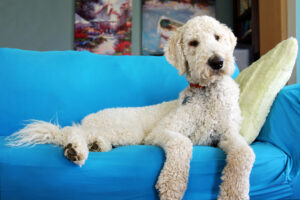
Housetraining
Even the easiest of puppies to housetrain will require you keep your carpet cleaner handy. If you are attentive and anticipate your puppy’s need to go outside, this training period can go quickly. One of the frequent mistakes new owners make with their puppies is the tendency to overcorrect for accidents that have already occurred. Puppies live entirely in the present. They do not “remember” acts of house soiling, and punishments given after the fact only confuse the puppy and harm your relationship with him/her.
That is why it is important to have your pup either with you or safely confined and not to allow the puppy to wander around the house unmonitored. We strongly suggest that you do NOT “rub your puppy’s nose in it,” “shout” at them for their accident, or “spank” them. For a correction to be meaningful, you must catch your pup in the act. Use a strong voice and say NO or UH-UH sweep him/her up in your arms and take her out immediately! Praise your puppy when going outside — “reward” their good behavior using positive reinforcement. This house training goes the quickest with your attentiveness to this training, your patience, and your anticipation of your puppy’s needs.
It is very important to keep the puppy on a consistent routine and not allow free roaming play without being sure they have relieved themselves first and free roaming with a continual eye on them. Create a schedule for feeding, playing, and times to take the puppy outside for potty breaks. They should go out at least every two hours and within 15 minutes after eating. Increase the time in 15 increments, slowly. The more you set your puppy up for success and not giving them the opportunity to go in the house, the more quickly they will be housebroke.
(See Sample Housetraining Schedule at the end)
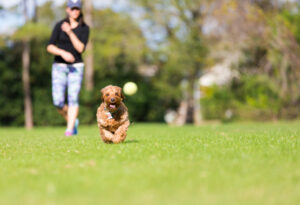
Exercise
Restrict pups exercise to sensible free moving activities or brief walks, and discourage jumping activities like Frisbee while the puppy is still growing. Extended and exhaustive playing with a puppy or forced exercise, can actually cause serious joint and bone problems later on, because of soft tissue development. These exercise restrictions are only necessary during the pup’s development period. We are not saying you can’t play with your pup at all; notice we are using the words: strenuous, extensive, excessive, extended, exhaustive, and forced exercise. We just want your pup to play and exercise “sensibly” because his bones and cartilage will not be fully developed until he reaches two years of age.
Many families love to jog, run, and take long walks with their Golden. Puppies need to go on shorter walks until at least one year of age. When starting to run or jog with your dog, start off slowly, just as you would when starting a new exercise program. Do not take your dog out for a 5-mile run the first time out. Gradually increase distance and time, as you would for your own body.
So you see, a Goldendoodle puppy is one who is easy to train, teach, and is very well behaved. If you have any questions, or need further insight about your new pups behavioural patterns at any time, feel free to call us here at Goldendoodle Dandies in Tulsa, Oklahoma.



